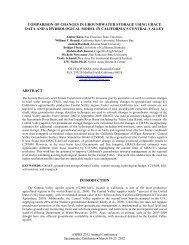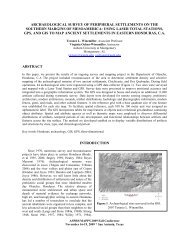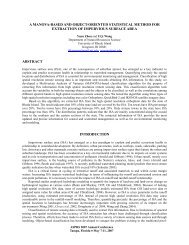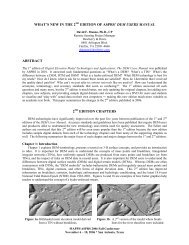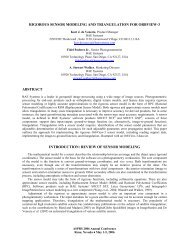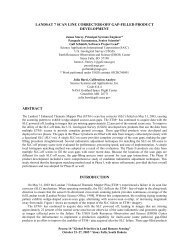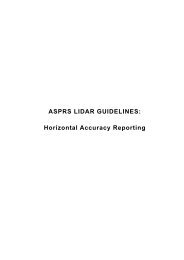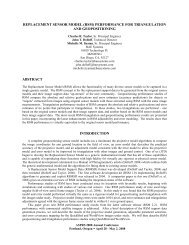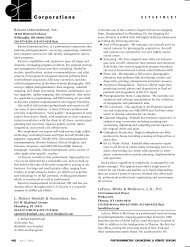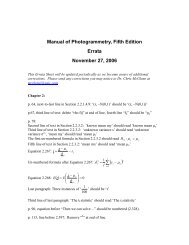LAS SPECIFICATION VERSION 1.4 – R11 - asprs
LAS SPECIFICATION VERSION 1.4 – R11 - asprs
LAS SPECIFICATION VERSION 1.4 – R11 - asprs
Create successful ePaper yourself
Turn your PDF publications into a flip-book with our unique Google optimized e-Paper software.
This record is simply an array of ASCII data. It contains many strings separated by null<br />
terminator characters which are referenced by position from data in the GeoKeyDirectoryTag<br />
record.<br />
Other Specification Defined VLRs<br />
C<strong>LAS</strong>SIFICATION LOOKUP: (optional)<br />
User ID: <strong>LAS</strong>F_Spec<br />
Record ID: 0<br />
Record Length after Header: 256 recs X 16 byte struct len<br />
struct C<strong>LAS</strong>SIFICATION<br />
{<br />
unsigned char ClassNumber;<br />
char Description[15];<br />
};<br />
TEXT AREA DESCRIPTION: (optional)<br />
User ID: <strong>LAS</strong>F_Spec<br />
Record ID: 3<br />
This VLR/EVLR is used for providing a textual description of the content of the <strong>LAS</strong> file. It is a<br />
null terminated, free-form ASCII string.<br />
EXTRA BYTES: (optional)<br />
User ID: <strong>LAS</strong>F_Spec<br />
Record ID: 4<br />
Record Length after Header: n records x 192 bytes<br />
The Extra Bytes VLR provides a mechanism whereby additional information can be added to the<br />
end of a standard Point Record. This VLR has been added to <strong>LAS</strong> <strong>1.4</strong> to formalize a process that<br />
has been used in prior versions of <strong>LAS</strong>. It is envisioned that software that is not cognizant of the<br />
meaning of the extra bytes will simply copy these bytes when manipulating files.<br />
This record is only needed for <strong>LAS</strong> files where points contain user-defined “extra bytes”. This<br />
happens when the point record size is set to a larger value than required by the point type. For<br />
example, when a <strong>LAS</strong> file that contains point type 1 has a point record size of 32 instead of 28<br />
there are 4 “extra bytes”. The Extra Bytes VLR contains a simple description of the type and the<br />
meaning of these “extra bytes” so they can be accessed in a consistent manner across<br />
applications. The 4 “extra bytes” could, for example, be of data_type 9 - a floating point value -<br />
that specifies an "echo width" for each return. In this case there would be one EXTRA_BYTES<br />
struct in the payload of this VLR. An example with two EXTRA_BYTES struct in the payload are<br />
14 "extra bytes" that have data type 29 - a floating point vector of length 3 - followed by data type<br />
3 - an unsigned short - that specify the "laser pulse direction" and a "normalized reflectivity".<br />
The "extra bytes" are made accessible via a unique name. The "name" field distinguishes the<br />
additional point attributes that a LIDAR software may add to the points in a <strong>LAS</strong> file so they can<br />
be accessed later in a consistent manner by another software. Descriptive names such as<br />
"normalized reflectivity", "echo width", or "shading normal" are encouraged. The use of generic<br />
names such as "variable1" or "temp1" is discouraged.<br />
American Society for Photogrammetry & Remote Sensing Page 24 of 27<br />
<strong>LAS</strong> <strong>SPECIFICATION</strong><br />
Version <strong>1.4</strong>-<strong>R11</strong>



